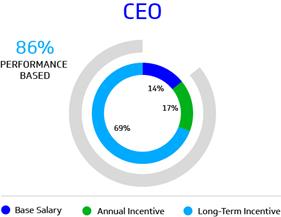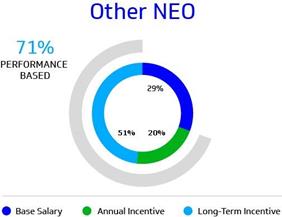POTENTIAL PAYMENTS UPON TERMINATION OR CHANGE IN CONTROL
Severance Plan and Change in Control Provisions
The Company maintains an Executive Severance Plan for qualifying employees. We have no individual change in control agreements with any of the NEOs. During 2019, the applicable change in control provisions were (i) the Executive Change in Control Severance Plan adopted upon completion of the
Spin-Off
in November 2017 for qualifying employees, (ii) the Change in Control Separation Benefit Plan and (iii) those provided in the Company’s incentive plans. Each of Messrs. Dauch, Sehgal, Harrington and Clarke participates in the Executive Change in Control Severance Plan. Mr. Quinlan participates in the Change in Control Separation Benefit Plan.
Each executive who participates in the annual Long-Term Incentive Plan equity grant must sign a grant agreement, as well as a
non-interference
and confidentiality agreement, described above in the “Compensation Discussion and Analysis” section. The
non-interference
agreement includes both
non-compete
and
non-solicitation
covenants.
The following definitions are applicable to the discussion of these arrangements:
| | • | “Qualifying Separation” means a separation of employment, including following a Change in Control, but in any event not by the Company for Cause and not as a result of a voluntary termination by the executive. |
| | • | “Change in Control” means a change in ownership or control of the Company resulting in (i) any person or group other than the Company or an employee benefit plan acquiring securities of the Company possessing more than 50% of the total combined voting power of the Company’s equity securities outstanding after such acquisition; (ii) the majority of the board as of the date of the Spin-Off is replaced by persons whose election was not approved by a majority of the incumbent board; or (iii) the sale of all or substantially all of the assets of the Company, in one or a series of related transactions, to any person or group other than the Company. |
| | • | “Cause” means with respect to any executive (i) the indictment for a felony or for any other crime that has or could be reasonably expected to have an adverse impact on performance of duties to the Company or on the business or reputation of the Company; (ii) being the subject of any order regarding a fraudulent violation of securities laws; (iii) conduct in connection with employment or service that is not taken in good faith and has resulted or could reasonably be expected to result in material injury to the business or reputation of the Company; (iv) willful violation of the Company’s Code of Ethical Business Conduct or other material policies; (v) willful neglect in the performance of duties, or willful or repeated failure or refusal to perform these duties; or (vi) material breach of any applicable employment agreement. |
| | • | “Good Reason” means with respect to any executive (i) a material diminution in base salary; (ii) a material diminution in authority, duties or responsibilities from those in effect immediately prior to the Change in Control; (iii) relocation of the executive’s principal place of employment more than 50 miles from the location immediately prior to the Change in Control; or (iv) any other action or inaction that is a material breach by the Company of any agreement under which the executive provides services to us. |
Executive Severance Plan.
The Executive Severance Plan provides for severance benefits in the event of a Qualifying Separation of an Eligible Executive’s employment. Pursuant to the Executive Severance Plan, an Eligible Executive who incurs a Qualifying Separation would be entitled to receive severance payments during the applicable severance period, unless and until the Eligible Executive is employed by another employer. The Executive Severance Plan also provides a COBRA subsidy for a period of up to 18 months following a Qualifying Separation for U.S. Executives.
Executive Change in Control Severance Plan.
Pursuant to the Executive Change in Control Severance Plan, an eligible executive who incurs a Qualifying Separation would be entitled to receive a lump sum cash payment in an amount equal to the sum of (a) three times base salary in the case of Mr. Dauch and two times base salary in the case of Messrs. Sehgal, Clarke and Harrington; and (b) in the case of Mr. Dauch, three times the higher of the CEO’s target annual cash incentive award opportunity for the year in which the separation occurs or in effect immediately prior to the Change in Control, or in the case of Messrs. Sehgal, Clarke and Harrington, two times the higher of the eligible executive’s target annual cash incentive award opportunity for the year in which the separation occurs or in effect immediately prior to the Change in Control. In addition, an eligible executive who incurs a Qualifying Separation is also entitled to receive a lump sum payment representing the sum of 36 monthly COBRA premiums for Mr. Dauch and 24 monthly COBRA premiums for Messrs. Sehgal, Clarke and Harrington.
Change in Control Separation Benefit Plan.
Pursuant to the Change in Control Separation Benefit Plan, an eligible executive who incurs a Qualifying Separation would be entitled to receive a lump sum cash payment in an amount equal to the sum of (a) 1.5 times the executive’s base salary; and (b) 1.5 times the higher of the executive’s target annual cash incentive award opportunity for the year in which the separation occurs or in effect immediately prior to the Change in Control. In addition, an eligible executive who incurs a Qualifying Separation is also entitled to receive a lump sum payment representing the sum of 18 monthly COBRA premiums.
In the event of a Change in Control, each executive’s annual incentive target award will be prorated for the time period between the plan start date and the effective change in control date. A payment will also be calculated for that time period based on actual performance and compared to the prorated target, with the executive receiving the larger of the two values. Payment of the award will be made by March 15 of the calendar year following the year in which a change in control occurs.
If involuntarily terminated without Cause, each executive, including the NEOs, will also be eligible for a prorated portion of his or her annual incentive award. The period used to determine the prorated award will be the beginning of the performance period to the individual’s termination date.
Long-Term Incentive Plan.
An equity award must be outstanding for one year in order to receive any benefit at termination. Upon a termination without Cause, for Good Reason or due to death or disability, the time-based RSUs will be prorated over the period between the grant date and termination date. Any unvested
pro-rata
awards will be delivered at the next scheduled vesting date.
Upon a termination without Cause, for Good Reason or due to retirement, death or disability, any outstanding performance-based RSUs will be prorated over the period between the grant date and termination date. The final performance payout will be determined at the end of the performance period and shares will be distributed at the time of the general distribution.
If an executive voluntarily departs (with the exception of the retirement provisions discussed above) or is terminated for Cause, or in the event of any termination prior to the first anniversary of the grant date, all outstanding unvested equity awards will be canceled.
Upon a Qualifying Separation within two years after a Change in Control, or upon a Change in Control if a replacement award is not provided, outstanding unvested equity awards will vest as follows:
| | • | Time-based RSUs will vest in full; and |
| | • | After a determination by the Compensation Committee of the Company’s performance at the time of the Change in Control, the number of performance-based RSUs that will vest will be equal to the greater of (a) the performance-based RSUs earned through the change in control date, or (b) 100% of the performance-based RSUs granted. |
A replacement award is an award with respect to the stock of Delphi Technologies or its successor that is at least equal in value to the outstanding award, is a publicly traded security and has no less favorable terms than the outstanding award. A qualifying termination after a change in control includes any termination by the Company without cause, or by the NEO for good reason, or due to death or disability.
| (2) | In the case of a qualifying termination, NEO’s are eligible to receive severance payments equal to 18 months of base salary in the case of two or more years of continuous service and 12 months of base salary for continuous service of less than 2 years. |
| (3) | In all scenarios except a voluntary termination or an involuntary termination for cause, the NEO would receive a prorated annual incentive award. If the NEO voluntarily terminates employment, he must have worked on the last business day of the year in order to receive his annual incentive award; if not, the award is forfeited in its entirety. For each NEO, annual incentive award payments are subject to performance assessment and will be paid after the conclusion of the performance period. Under a change in control, the payment of the annual incentive award would be at the greater of target or actual; target is reflected above. |
| (4) | In the event of a qualifying termination within two years after a change in control the NEOs’ awards will vest as described under “Long-Term Incentive Plan”. Also as described under “Long-Term Incentive Plan”, if at the time of a change in control the NEOs do not receive replacement awards, their awards will vest upon the change in control regardless of whether their employment is terminated. The performance-based RSUs included represent a 100% payout of each award. |
| (5) | As of December 31, 2019, none of our NEO’s were eligible to retire. |
As required by Section 409A of the Internal Revenue Code, all NEOs who have elected to participate in the SRESP must wait six months to receive a payment under the plan by reason of termination of employment. Payments for departure on December 31, 2019 would be made within 60 days after July 1, 2020. All amounts are estimates only, and actual amounts will vary depending upon the facts and circumstances applicable at the time of the triggering event.
As required by Section 953(b) of the Dodd-Frank Wall Street Reform and Consumer Protection Act and Item 402(u) of Regulation
S-K,
we are providing the following information about the relationship of the median of the annual total compensation of our employees and the annual total compensation of our Chief Executive Officer. For 2019, the annual total compensation of our median employee was $19,015
and the annual total compensation of our CEO was $11,687,671 (which includes the
one-time
stock option grant made to Mr. Dauch in January 2019). Based on this information, for 2019 our CEO’s annual total compensation was 615
times that of the median of the annual total compensation of all our employees. In making this calculation, we used the following methodology:
| | • | Total CEO compensation was determined using the amount shown in the “Total” column in the Summary Compensation Table included in this report. Please note that Mr. Dauch’s salary (only) was annualized for the CEO Pay Ratio calculation. |
| | • | We determined that, as of October 31, 2019, our employee population consisted of approximately 19,000full-time, part-time, and temporary global employees. To identify the median employee from our global employee population, we first determined each employee’s taxable wages as of October 31, 2019, as reflected in our payroll records and systems. We then identified our median employee from our global employee population based on this compensation measure. We did not make any cost of living adjustments in identifying the median employee. The median employee’s total compensation represents the amount of such employee’s compensation as of October 31, 2019 that would have been reported in the Summary Compensation Table in accordance with the requirements of Item 402(c)(2)(x) of Regulation S-K if the employee was a NEO for 2019. |












